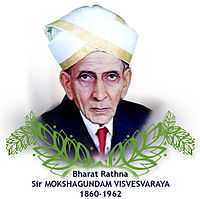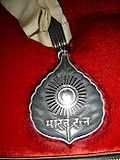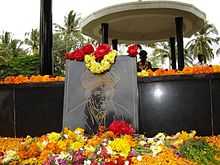Visvesvaraya
| Sir Mokshagundam Visvesvaraiah KCIE | |
|---|---|
 | |
| Diwan of the Mysore kingdom | |
| In office 1912–1918 | |
| Monarch | Krishna Raja Wadiyar IV |
| Preceded by | T. Ananda Rao |
| Succeeded by | M. Kantaraj Urs |
| Personal details | |
| Born | 15 September 1860 Muddenahalli, Chikballapur, Kingdom of Mysore (now in Karnataka) |
| Died | 14 April 1962 (aged 101) Bangalore |
| Nationality | Indian |
| Alma mater | COEP |
| Occupation | Engineer, Diwan |
| Profession | Engineer |
| Religion | Hindu |
Sir Mokshagundam Vishveshwariah KCIE, (popularly known as Sir MV; 15 September 1860[1] – 14 April 1962[1]) was a notable Indian engineer, scholar, statesman and the Diwan of Mysore during 1912 to 1918. He was a recipient of the Indian Republic's highest honour, the Bharat Ratna, in 1955. He was knighted as a Knight Commander of the Indian Empire (KCIE) by King George V for his contributions to the public good. Every year, 15 September is celebrated as Engineer's Day in India in his memory. He is held in high regard as a pre-eminent engineer of India. He was the chief designer of the flood protection system for the city of Hyderabad, now capital city of Andhra Pradesh, as well as the chief engineer responsible for the construction of the Krishna Raja Sagara dam in Mandya.
Early years
Sir MV was born in 1860 September 15 in a Telugu Brahmin[2][3] family to Mokshagundam Srinivasa Shastry and Venkatalakshmamma in Muddenahalli village,[4] 40 miles from Bangalore, Mysore State (now Karnataka), India. Mokshagundam is a village in Prakasam District's Cumbum Tahasil (then Kurnool District ) of Andhra Pradesh where the ancestors of Visvesvarayya emigrated from.[5] Visvesvaraya lost his father at the age of 15. He enrolled for kannada medium primary school in Chikballapur and attended high school in Bangalore. He earned his Bachelor of Arts from Central College, Bangalore affiliated to Madras University in 1881 and later studied civil engineering at the prestigious College of Engineering, Pune, popularly known as COEP.[6]
Career as an engineer
Upon graduating as an engineer, Visvesvaraya took up a job with the Public Works Department (PWD) of Mumbai and was later invited to join the Indian Irrigation Commission. He implemented an extremely intricate system of irrigation in the Deccan area. He also designed and patented a system of automatic weir water floodgates that were first installed in 1903 at the Khadakvasla Reservoir near Pune. These gates were employed to raise the flood supply level of storage in the reservoir to the highest level likely to be attained by a flood without causing any damage to the dam. Based on the success of these gates, the same system was installed at the Tigra Dam in Gwalior and the Krishna Raja Sagara (KRS) Dam in Mandya/ Mysore,Karnataka. In 1906–07, the Government of India sent him to Eden, Africa to study water supply and drainage system and the project prepared by him was implemented in Eden successfully. Visvesvaraya achieved celebrity status when he designed a flood protection system for the city of Hyderabad. He was instrumental in developing a system to protect Visakhapatnam port from sea erosion.[7] Visvesvaraya supervised the construction of the KRS Dam across the Kaveri River from concept to inauguration. This dam created the biggest reservoir in Asia when it was built.[8] He was rightly called the "Father of modern Mysore state" (now Karnataka): During his period of service with the Government of Mysore state, he was responsible for the founding of, (under the Patronage of Mysore Government), the Mysore Soap Factory, the Parasitoide Laboratory, the Mysore Iron & Steel Works (now known as Visvesvaraya Iron and Steel Limited) in Bhadravathi, the Sri Jayachamarajendra Polytechnic Institute, the Bangalore Agricultural University, the State Bank of Mysore, The Century Club, Mysore Chambers of Commerce and numerous other industrial ventures. He encouraged private investment in industry during his tenure as Diwan of Mysore. He was instrumental in charting out the plan for road construction between Tirumala and Tirupati. He was known for sincerity, time management and dedication to a cause.
Career In Brief
- Joined service as Assistant Engineer in Bombay, 1884; served in Nasik, Khandesh and Poona;
- services lent to Municipality of Sukkur in Sind, 1894: designed and carried out the water works of that Municipality, 1895;
- Executive Engineer, Surat, 1896;
- Assistant Superintending Engineer, Poona, 1897–99; visited China and Japan, 1898;
- Executive Engineer for Irrigation, Poona, 1899;
- Sanitary Engineer, Bombay, and Member, Sanitary Board, 1901; gave evidence before the Indian Irrigation Commission, 1901;
- designed and constructed Automatic Gates patented by him at Lake Fife Storage Reservoir; introduced a new system of irrigation known as the "Block System", 1903; represented the Bombay Government at the Simla Irrigation Commission, 1904; on special duty, 1905;
- Superintending Engineer, 1907; visited Egypt, Canada. United States of America and Russia, 1908;
- services lent as Special Consulting Engineer, Hyderabad, to supervise and carry out Engineering works in connection with the Musi floods, 1909;
- retired from British service, 1909;
- Chief Engineer and Secretary to the Government of Mysore, 1909;
- Dewan of Mysore, P. W. and Railway Department, 1913.
Diwan of Mysore
After opting for voluntary retirement in 1908, he took a foreign tour to study industrialised nations and after, for a short period he worked for the Nizam of Hyderabad, India. He suggested flood relief measures for Hyderabad town, which was under constant threat of floods by Musi river. Later, during November 1909, Visvesvaraya was appointed as Chief Engineer of Mysore State. Further, during the year, 1912, he was appointed as Diwan (First Minister) of the princely state of Mysore. He was Diwan for 7 years.
With the support of Krishnaraja Wodeyar IV, Maharaja of Mysore, Visvesvaraya made good contribution as Diwan to the all-round development of Mysore state. Not only the achievements listed above, but many other industries and public works owe their inception or active nurturing to him. He was instrumental in the founding of the Government Engineering College at Bangalore in 1917, one of the first engineering institutes in India. This institution was later named the University Visvesvaraya College of Engineering after its founder. He also commissioned several new railway lines in Mysore state.
Awards and honours


Visvesvaraya was appointed a Companion of the Order of the Indian Empire (CIE) in 1911.[9] In 1915, while he was the Diwan of Mysore, Visvesvaraya was knighted as a Knight Commander of the Order of the Indian Empire (KCIE) by the British for his myriad contributions to the public good.[10] After India attained independence, he was awarded with the nation's highest honour, the Bharat Ratna, in 1955.[11] He was feted with honorary membership of the international Institution of Civil Engineers (based in London) and a fellowship of the Indian Institute of Science (based in Bangalore). He was awarded several honorary doctoral degrees like D.Sc., LL.D., D.Litt. from eight universities in India. He was president of the 1923 Session of the Indian Science Congress. Sir M.V. was awarded honorary Membership of London Institution of Civil Engineers for an unbroken 50 years.[12] He was the most popular person from Karnataka, in a newspaper survey conducted by Prajavani.
Recognition
Visvesvaraya has received recognition in various fields, most notably the education sector and the engineering sector. Visvesvaraya Technological University which is based in Belgaum, the University to which most engineering colleges in Karnataka are affiliated to, has been named in his honour, as well as prominent colleges like University Visvesvaraya College of Engineering, Bangalore, Sir M. Visvesvaraya Institute of Technology, Bangalore and Visvesvaraya National Institute of Technology, Nagpur. College of Engineering, Pune, his alma mater, has erected a statue in his honor.[13] The Visvesvaraya Industrial and Technological Museum, a museum in Bangalore is named in his honor.
Memorial at Muddenahalli

The Visvesvaraya National Memorial Trust manages a memorial of Visvesvaraya at his birthplace Muddenahalli. The memorial exhibits his awards, titles and personal belongings, including his living room, spectacles, cups, his copy of the Webster's dictionary, and a block with which his visiting cards were printed. Models of the Krishna Raja Sagar dam, which Visvesvaraya designed and supervised the construction of, are also exhibited. The memorial is located adjacent to his house, which was refurbished and regarded as a temple by the locals.[14][15]
Works
- Visvesvaraya, M (1920), Reconstructing India, P. S. King & son, ltd, OCLC 2430680
- Visvesvaraya, M (1936), Planned economy for India, Bangalore: Bangalore Press, OCLC 19373044
- Visvesvaraya, M (1951), Memories of my working life, Bangalore, OCLC 6459729
- Visvesvaraya, M (1932), Unemployment in India; its causes and cure, Bangalore: The Bangalore Press, OCLC 14348788
- Visvesvaraya, M (1917), Speeches, Bangalore: Govt. Press, OCLC 6258388
- A Brief Memoir of my complete working life, Government Press, Bangalore, 1959
See also
- Dr. K.L. Rao
- Dr. K. Sriramakrishnaiah
References
- ↑ 1.0 1.1 Sir M. Visvesvaraya | Sir MV | Karnataka Personalities. Karnataka.com (1 October 2007). Retrieved on 30 December 2013.
- ↑ Nath, Pandri (1987). Mokshagundam Visvesvaraya: life and work. Bharatiya Vidya Bhavan. p. 47.
- ↑ The Astrological Magazine 88. 1999. p. 448.
- ↑ Karnataka News : Remembering Karnataka's icon – Sir. M. Visvesvaraya. The Hindu (15 September 2010). Retrieved on 30 December 2013.
- ↑ Nath, Pandri (1987). Mokshagundam Visvesvaraya: life and work. Bharatiya Vidya Bhavan. p. 3.
- ↑ Kannada Anubhava. Bangalore: Department of Kannada, RV College of Engineering. 2010.
- ↑ "Visvesvaraya's services recalled". The Hindu. 16 September 2006. Retrieved 21 March 2011.
- ↑ Husain, Dildar (1966) An Engineering Wizard of India, Institution of Engineers (India) AP, Hyderabad.
- ↑ The London Gazette: no. 28559. p. 9363. 8 December 1911.
- ↑ The London Gazette: (Supplement) no. 29180. p. 5329. 1 June 1915.
- ↑ "Padma Awards Directory (1954–2007)". Ministry of Home affairs. Retrieved 26 November 2010.
- ↑ "Welcome to Chikballapur District – Visvesvaraya". Chikballapur.nic.in. Retrieved 11 August 2010.
- ↑ "Engineer's Day 2010 Celebrations". Today24news. 15 September 2010. Retrieved 28 October 2011.
- ↑ "MV memorabilia give glimpses of a genius". DNA India. 13 August 2011. Retrieved 28 October 2011.
- ↑ Kamath, Vijesh (8 September 2009). "For locals, Vivesvaraya’s house is a place of worship". Deccan Herald. Retrieved 28 October 2011.
External links
| Wikimedia Commons has media related to Mokshagundam Visvesvaraiah. |
| Wikisource has original text related to this article: |
- Memoirs of my working life (1951)
- A list of books on Sir MV, complied by the Institute of Engineers (India)
- Sir Mokshagundam Visvesvaraya – A Visionary Engineer par Excellence
- A biography of Sir MV
- Another biography relating several interesting anecdotes
- On Sir MV's role as founder of the State Bank of Mysore
- Why every Kannadiga should be proud of Sir MV Visvesvaraya
- Visvesvaraya, an engineer of modernity
| Political offices | ||
|---|---|---|
| Preceded by T. Ananda Rao |
Diwan of Mysore (1912–1919) |
Succeeded by M. Kantaraj Urs |
